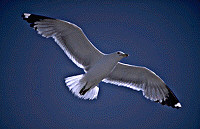

Building a MOAT around Your Castle
The four keys to better photography
by Ron Alan Pierce
A helpful technique is to consider a photo as like a castle: completely self-contained, and protected from it's enemies by a "Moat". The enemies of a photograph are: (1) imbalance in proportions of shape/form/color (composition), (2) distractions from the main subject, (3) over-brightness and lack of sharpness, and (4) lack of time (a "snap" shot). The letters of the word "MOAT" makes it a nice mnemonic for the process that will help you create photographic "castles".
Move --- When you see something, MOVE! Move left, right, forward, backward, up, down. Find the POSITION that seems to work best for your subject. An artist visualizes a position, a perspective, and paints that. We, as photographers, must FIND the best perspective, by moving until the "feeling" in that photo-rectangle is just right. Exercise: spend ten minutes walking completely around a subject, looking through the camera as you move forward/backward/up/down (even down to the ground!) This step is all about how the image feels --- avoid "thinking"!
Other-stuff.
Once you've picked a position, and are looking through the camera, watch for the "other stuff" that may distract from your photo and the feeling you are trying to capture. It can be a distracting shape/form, a color, or an object, often around the "edges" and "corners". Or it can be over-bright areas --- cameras tend to make create a high contrast between light and shadow areas. You see the flower, and it's beauty, but sadly, someone else looking at the photo later will be immediately distracted by a portion of a branch or stem on the left side of the image, or another flower in the background. So you move into a better position, to keep the "Other stuff" from being a distraction.
Tip: defocus the image; feel the colors/shapes/forms without an identifiable "subject".
These first two elements, MO, are the "composition", wherein you try to capture, in a rectangle, something complete and harmonious. These must be done BEFORE you start your "technical thinking" about the camera-settings.
Adjustments --- to your camera settings. Now that you have got your position, you must decide on the aperture (F/stop) and shutter speed combination. Most lenses will go from F/2 (wide open, lets in lots of light, but little depth-of-focus) to F/16 (barely open, little light, but great depth-of-focus). For hand-held cameras (all of my work is hand-held), there is also shutter-speed consideration. If nothing is in motion in the image, a 50mm lens requires at least 1/50 second speed, a 300mm telephoto at least 1/300 second --- in other words, you only have to remember the lens size (or telephoto setting) to know what your slowest speed can reasonably be. Even then, exhale, and relax your tongue and jaw muscles before you press the shutter; many pros try to snap between heartbeats. You can also "brace" the camera on a rock or backpack, against a tree, etc., to use slow shutter speeds of even 1 second (for low-light situations or to gain more depth-of-focus).
Usually the MOST important adjustment, however, is the light-meter adjustment. Most cameras will automatically "meter" the light --- but it is CRITICAL to point the camera at the "brightest" area of the photo (even move in closer to it) to get the meter-setting for locking-in the aperture or shutter-speed. Most photos are "overexposed" (some areas are too bright) because the "meter" tends to look mostly at the CENTER of the image (rarely the brightest) or (worse) take some "average" reading of the entire image.
Important: there is no way around it --- you will have to take a lot of photos initially (and record what you did) to see the effects of the F/stop (aperture) and shutter speeds, and how to "stop" the motion of the waves or leaves in the wind. Then, you'll know what to do in a situation. Also, different films (or different digital-camera settings) affect the camera's rendition of the colors your eye sees --- what you see is NOT going to be quite the same as what you get.
Time --- "Take Time, not Pictures". Slow down! Eventually, you'll often take just one photo, once you have done the MOA, if you take lots of time doing the MO, just "feeling" the image. Even after the MOA, pause to review the MO; then consider whether waiting might improve the image. You might want to wait for a cloud, a wave, for the wind to abate, for a slight change in light.
Exercise: The light changes dramatically during the day; find an immovable subject, and photograph it four of five different times during the day. Each time, if you do the MOA slowly and carefully, you'll find that a different position works best.
That's it --- Move, Other stuff, Adjustments, and Time. MOAT. Get adept at these with landscapes, which don't move, and you'll soon be able get "castle" photos of family, friends, and other "moving" subjects, because the MOA part will be second-nature, and you will be able to position yourself quickly and have preset the settings (I guess that moving-subjects photography is more like AMO!).
Landscape photography is a good way to start learning photography, because the subjects don't move very fast! Then, once using a camera and particular kind of film have become second-nature, it's easy to move into other kinds of photography.